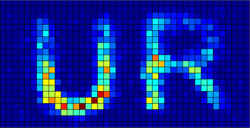
Too much to blog about! I’m getting backlogged… And just to complicate matters, here’s a new graphic from the European Sapce Agency that’s too much to pass up.
The image above shows Titan, Saturn’s largest moon, as seen in a slightly odd mix of visible and infrared light (if you really must know). The white line beneath Titan shows a “light curve,” which represents the intensity of light on the vertical axis, time on the horizontal axis, indicating the brightness of the star measured as it “passed behind” Titan through a trick of rotational and orbital dynamics in our solar system. The dimming of the star as it passes behind Titan reveals information about the moon’s atmosphere, and the peak of light in the center shows that the atmosphere acts like a lens, focussing light from the opposite side of the planet. The press release goes into some detail about how much we can learn from such observations, right down to predicting a bumpy ride for a spacecraft!
Now, I won’t claim my explanation above as the be-all-end-all, but I think the caption on ESA’s page doesn’t offer enough information about what’s going on in the still image. It never explains the term “light curve,” for example. I understand the reluctance to put words on the graphic (not so much for NASA, but for ESA serving a multilingual constituency), but the caption should compensate.
The animation of the graphic shows what’s happening much better, and I imagine the still image will make sense to people once they’ve seen the animation. N.B. that the caption for the animation is the same length as the caption for the still image—a stylistic requirement, I’m guessing. But the still image, with so much less information in it and so much more information implied by it, requires more verbiage to support it.






